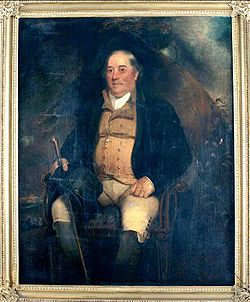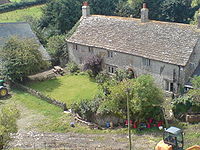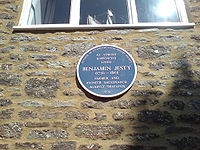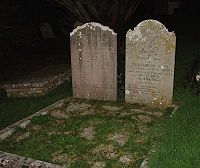
Benjamin Jesty
Encyclopedia

Yetminster
Yetminster is a village in the English county of Dorset. It lies within the West Dorset administrative district of the county, about five miles south-west of the town of Sherborne. It is sited on the River Wriggle, a tributary of the River Yeo, and is built almost entirely of honey-coloured...
in Dorset
Dorset
Dorset , is a county in South West England on the English Channel coast. The county town is Dorchester which is situated in the south. The Hampshire towns of Bournemouth and Christchurch joined the county with the reorganisation of local government in 1974...
, England
England
England is a country that is part of the United Kingdom. It shares land borders with Scotland to the north and Wales to the west; the Irish Sea is to the north west, the Celtic Sea to the south west, with the North Sea to the east and the English Channel to the south separating it from continental...
, notable for his early experiment in inducing immunity
Artificial induction of immunity
Artificial induction of immunity is the artificial induction of immunity to specific diseases - making people immune to disease by means other than waiting for them to catch the disease. The purpose is to reduce the risk of death and suffering....
against smallpox
Smallpox
Smallpox was an infectious disease unique to humans, caused by either of two virus variants, Variola major and Variola minor. The disease is also known by the Latin names Variola or Variola vera, which is a derivative of the Latin varius, meaning "spotted", or varus, meaning "pimple"...
using cowpox
Cowpox
Cowpox is a skin disease caused by a virus known as the Cowpox virus. The pox is related to the vaccinia virus and got its name from the distribution of the disease when dairymaids touched the udders of infected cows. The ailment manifests itself in the form of red blisters and is transmitted by...
.
The notion that those people infected with cowpox, a relatively mild disease, were subsequently protected against smallpox was not an uncommon observation with country folk in the late 18th century, but Jesty was one of the first to intentionally administer the less virulent virus
Virus
A virus is a small infectious agent that can replicate only inside the living cells of organisms. Viruses infect all types of organisms, from animals and plants to bacteria and archaea...
. He was one of the six English, Danish and German people who reportedly administered cowpox to artificially induce immunity
Artificial induction of immunity
Artificial induction of immunity is the artificial induction of immunity to specific diseases - making people immune to disease by means other than waiting for them to catch the disease. The purpose is to reduce the risk of death and suffering....
against smallpox from 1770 to 1791; only Gloucestershire apothecary and surgeon Dr John Fewster's 1765 paper in the London Medical Society and Jobst Bose of Göttingen
Göttingen
Göttingen is a university town in Lower Saxony, Germany. It is the capital of the district of Göttingen. The Leine river runs through the town. In 2006 the population was 129,686.-General information:...
, Germany
Germany
Germany , officially the Federal Republic of Germany , is a federal parliamentary republic in Europe. The country consists of 16 states while the capital and largest city is Berlin. Germany covers an area of 357,021 km2 and has a largely temperate seasonal climate...
with his 1769 inoculations pre-dated Jesty's work.
Unlike Edward Jenner
Edward Jenner
Edward Anthony Jenner was an English scientist who studied his natural surroundings in Berkeley, Gloucestershire...
, a medical doctor who is given broad credit for developing the smallpox vaccine in 1796, Jesty did not publicise his findings made some twenty years earlier in 1774.
Early life

Longburton
Longburton is a village in west Dorset, England, three miles south of Sherborne. The village has a population of 435 .-Geography:...
, four miles north-east of Yetminster. The couple lived at Upbury Farm, next to Yetminster churchyard, and the couple had four sons and three daughters.
Jesty and smallpox
During the eighteenth century smallpox was widespread throughout England, with frequent epidemics. It was known in the dairy-farming areas in the south-west of the country that the milkmaids and other workers who contracted cowpox from handling cows' udders, were afterwards immune to smallpox. Such people were able to nurse smallpox victims without fear of contracting the disease themselves. This folk-knowledge gradually became more widely disseminated amongst the medical community: in 1765 a Dr Fewster (possibly John Fewster) of Thornbury, GloucestershireThornbury, South Gloucestershire
Thornbury is a market town in South Gloucestershire, England, approximately 12 miles north of the city of Bristol, with a population of 12,342 at the 2001 UK census. The town hosts South Gloucestershire Council headquarters and is twinned with Bockenem in Germany. Thornbury is a Britain in Bloom...
presented a paper to the Medical Society of London
Medical Society of London
The Medical Society of London is one of the oldest surviving medical societies in the United Kingdom ....
entitled "Cow pox and its ability to prevent smallpox", and Dr. Rolph, another Gloucestershire physician, stated that all experienced physicians of the time were aware of this.
Jesty and two of his female servants, Ann Notley and Mary Reade, had been infected with cowpox. When an epidemic of smallpox came to Yetminster in 1774, Jesty decided to try to give his wife Elizabeth and two eldest sons immunity by infecting them with cowpox. He took his family to a cow at a farm in nearby Chetnole
Chetnole
Chetnole is a village in west Dorset, England, seven miles south of Sherborne. There are around 128 houses in the village. It has a public house in the heart of the village called The Chetnole Inn which is in the Michelin Guide, and was named The Best Freehouse in the UK by the Great British Pub...
that had the disease, and using a darning needle, transferred pustular material from the cow by scratching their arms. The boys had mild local reactions and quickly recovered but his wife's arm became very inflamed and for a time her condition gave cause for concern, although she too recovered fully in time.

Interest in the prophylactic powers of cowpox virus grew and in May 1796, over 20 years after Jesty had made his inoculations, Edward Jenner
Edward Jenner
Edward Anthony Jenner was an English scientist who studied his natural surroundings in Berkeley, Gloucestershire...
began his series of vaccination
Vaccination
Vaccination is the administration of antigenic material to stimulate the immune system of an individual to develop adaptive immunity to a disease. Vaccines can prevent or ameliorate the effects of infection by many pathogens...
experiments. In about 1797 Jesty and his family moved from Yetminster, when Jesty took up the tenancy of Downshay Manor Farm in Worth Matravers
Worth Matravers
Worth Matravers is a village and civil parish in the English county of Dorset. The village is situated on the cliffs west of Swanage. It comprises limestone cottages and farm houses and is built around a pond, which is a regular feature on postcards of the Isle of Purbeck.The civil parish stretches...
near the Dorset
Dorset
Dorset , is a county in South West England on the English Channel coast. The county town is Dorchester which is situated in the south. The Hampshire towns of Bournemouth and Christchurch joined the county with the reorganisation of local government in 1974...
coast. Here he came to the attention of Dr. Andrew Bell, rector of nearby Swanage
Swanage
Swanage is a coastal town and civil parish in the south east of Dorset, England. It is situated at the eastern end of the Isle of Purbeck, approximately 10 km south of Poole and 40 km east of Dorchester. The parish has a population of 10,124 . Nearby are Ballard Down and Old Harry Rocks,...
who (possibly encouraged by Jesty's efforts) vaccinated over 200 of his practitioners in 1806.
Recognition and final years
In June 1802 Jenner was given a reward of £10,000 from the House of Commons for discovering and promoting vaccination, and another award of £20,000 followed in 1807. Before this first amount had been awarded, George Pearson, founder of the Original Vaccine Pock Institution, had brought evidence before the House of Commons of Jesty's work in 1774, work which pre-dated Jenner's by 22 years. Unfortunately, Jesty's well-documented case was weakened by his failure to petition in person, and Pearson's inclusion of other claimants whose evidence could not be validated, so no reward was forthcoming.Unaware of George Pearson’s previous petitions to the Pitt Government about the Dorset farmer, the Reverend Dr. Andrew Bell, rector of Swanage near where Jesty later resided, prepared a paper dated 1 August 1803, proposing Jesty as the first vaccinator, and sent copies to the Original Vaccine Pock Institute and the member of parliament, George Rose. Bell wrote to the Institution again in 1804, having learned of Pearson's involvement.
In 1805, at Pearson's instigation and the institution's invitation, Jesty gave his evidence before 12 medical officers of the institution at its base on the corner of Broadwick Street and Poland Street in Soho. Robert, Jesty's oldest son (by then 28 years old) also made the trip to London and agreed to be inoculated with smallpox again to prove that he still had immunity. After Jesty had been cross-examined, he was presented with a long testimonial and pair of gold mounted lancets. The verbal evidence of their examination was published in the Edinburgh Medical and Surgical Journal.
Report from the Original Vaccine Pock Institute, 1805 "That he was led to undertake this novel practice in 1774 to counteract the small-pox, at that time prevalent at Yetminster, where he then resided, from knowing the common opinion of the country ever since he was a boy (now 60 years ago) that persons who had gone through the cowpock naturally, ie by taking it from cows, were insusceptible of the small-pox; by himself being incapable of taking the small-pox, having gone through the cow-pock many years before; from knowing many individuals, who, after the cowpock, could not have the small-pox excited; from believing that the cow-pock was an affection free from danger; and from his opinion that, by the cow-pock inoculation, he should avoid ingrafting various diseases of the human constitution, such as "the Evil (scrofula), madnes, lues (syphilis), and many bad humours," as he called them."

Great Marlborough Street
Great Marlborough Street runs west to east through the western part of Soho in London. At its western end it joins Regent Street. Streets intersecting, or meeting with, Great Marlborough Street are, from west to east, Kingly Street, Argyll Street, Carnaby Street, and Poland Street...
. Jesty proved an impatient sitter, and so Mrs Sharp played the piano to try to soothe him as Sharp painted. After a chequered history, the portrait is now owned by the Wellcome Trust and is on loan to the Dorset County Museum. It will be shown here from the 26th October 2009 to February 2010. The painting will be shown a small display of vaccination equipment.
On Sunday 15 July 1806, Bell preached the same sermon twice in honour of Jesty, "whose discovery of the efficacy of the cowpock against smallpox is so often forgotten by those who have heard of Dr Jenner".
Jesty died in Worth Matravers on 16 April 1816 and was buried in a prominent position in the parish churchyard. His widow, Elizabeth, died on 8 January 1824 and was buried alongside him. Both headstones are listed structures, primarily due to their historic interest. The full text on Jesty's headstone reads:
(Sacred) To the Memory OF Benj.in. Jesty (of Downshay) who departed this Life, April 16th 1816 aged 79 Years. He was born at Yetminster in this County, and was an upright honest Man: particularly noted for having been the first Person (known) that Introduced the Cow Pox by Inoculation, and who from his great strength of mind made the Experiment from the (Cow) on his Wife and two Sons in the Year 1774.
Further reading
- Patrick J Pead, 2003, "Benjamin Jesty: new light in the dawn of vaccination" The LancetThe LancetThe Lancet is a weekly peer-reviewed general medical journal. It is one of the world's best known, oldest, and most respected general medical journals...
Volume 362, Issue 9401, 20 December 2003, pages 2104-2109 (online at http://www.jesty.org/) - Patrick J Pead, 2006, "Benjamin Jesty: the first vaccinator revealed" The Lancet Volume 368, Issue 9554, 23 December 2006, page 2202

